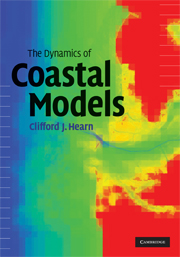Book contents
- Frontmatter
- Contents
- Preface
- Acknowledgements
- Note on mathematics and model codes
- 1 Prelude to modeling coastal basins
- 2 Currents and continuity
- 3 Box and one-dimensional models
- 4 Basic hydrodynamics
- 5 Simple hydrodynamic models
- 6 Modeling tides and long waves in coastal basins
- 7 Mixing in coastal basins
- 8 Advection of momentum
- 9 Aspects of stratification
- 10 Dynamics of partially mixed basins
- 11 Roughness in coastal basins
- 12 Wave and sediment dynamics
- References
- Index
- References
3 - Box and one-dimensional models
Published online by Cambridge University Press: 18 December 2009
- Frontmatter
- Contents
- Preface
- Acknowledgements
- Note on mathematics and model codes
- 1 Prelude to modeling coastal basins
- 2 Currents and continuity
- 3 Box and one-dimensional models
- 4 Basic hydrodynamics
- 5 Simple hydrodynamic models
- 6 Modeling tides and long waves in coastal basins
- 7 Mixing in coastal basins
- 8 Advection of momentum
- 9 Aspects of stratification
- 10 Dynamics of partially mixed basins
- 11 Roughness in coastal basins
- 12 Wave and sediment dynamics
- References
- Index
- References
Summary
The value of box models
Conservation of mass and momentum are the two basic laws which govern the way that coastal basins respond to multiple environmental forcings. Box models capture much of the basic physics of mass conservation, and in this chapter we explore the use of box models. This is part of our general aim of using simple models to illustrate the basic science of coastal basins. Box models are also of practical value in determining some of the bulk, or overall properties, of coastal basins, and are arguably the first type of modeling tool that should be applied to any system before more detailed models are used. Momentum conservation is the basis of the dynamics which we will consider in Chapter 4, and is included in box models mainly through various calibration coefficients.
Apart from mass and momentum, many other quantities in coastal basins are conserved. The most important of these conserved quantities is salt. Coastal basins usually contain a mixture of marine and fresh water, so that their mean salinity provides a measure of the relative fluxes of marine and fresh water through the basin. By knowing long-term freshwater influx, and net precipitation/evaporation (from the surface of the basin), it is possible to determine marine fluxes, i.e., the rate of exchange of basin water with the open ocean (or continental shelf) outside the coastal basin. This is basically a salt balance or salt budget for the basin.
- Type
- Chapter
- Information
- The Dynamics of Coastal Models , pp. 67 - 101Publisher: Cambridge University PressPrint publication year: 2008

